Celtic Salt vs Himalayan Salt
Are you tired of using regular old table salt in your cooking? Looking for a healthier and more flavorful alternative? Well, you’re in luck because there are many different types of natural salts available on the market today. Two popular choices are Celtic salt and Himalayan salt.
While they may seem similar, there are actually some key differences between these two salts. In this article, we’ll take a closer look at Celtic salt and Himalayan salt, and explore the pros and cons of each. So, grab a seat and get ready to discover the world of natural salts!
What is Celtic Sea Salt?
Celtic Sea Salt is a natural salt that is harvested from the coastal region of Brittany, France. Uniqueness of Celtic Sea Salt comes from its unique harvesting process. Skilled workers hand-rake the salt from salt ponds using traditional methods that have been passed down for generations. This process allows the salt to retain its natural minerals, including calcium, magnesium, and potassium. These minerals give Celtic Sea Salt a slightly greyish hue and a distinct flavor that is often described as “earthy” or “briny”.
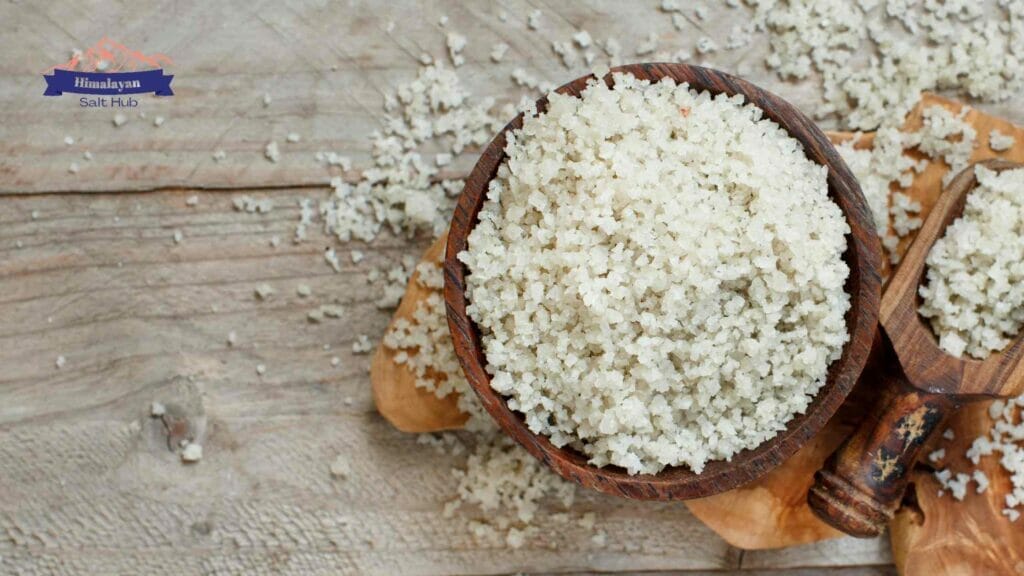
Unlike table salt, that is heavily processed and often contains anti-caking agents and additives, Celtic Sea Salt is unrefined and free from artificial chemicals. Just like Pink Himalayan Salt, Celtic Sea Salt has many uses. Here are some of common uses of Celtic Salt:
- Use as a seasoning for meats, vegetables, and soups to add flavor and enhance nutritional value.
- Sprinkle on salads and roasted nuts for a crunchy texture and a burst of flavor.
- Use in baking recipes such as bread and cookies to enhance the flavor profile.
- Combine with essential oils for a relaxing and revitalizing bath soak.
- Use as a natural remedy for sore throat and sinus congestion by adding to warm water and gargling or inhaling steam.
- Use as a natural exfoliant for skin by mixing with coconut oil or other carrier oils.
Celtic Salt vs Himalayan Salt
We have listed Celtic Salt vs Himalayan Salt for you to better understand the difference between two natural salts.
Celtic Salt vs Himalayan Salt: Origin and Mineral Composition
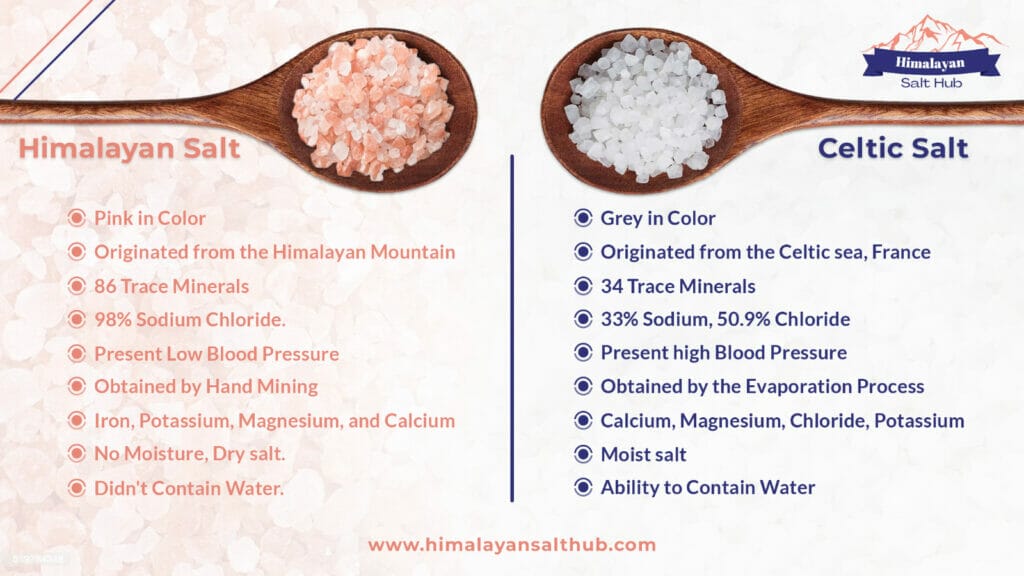
Celtic Sea Salt is harvested from the coastal regions of France, while Himalayan Salt is sourced from the Khewra salt mines in foothills of the Himalayan Mountains. Celtic Salt is primarily composed of sodium chloride and contains trace amounts of minerals like magnesium, calcium, and potassium.
In contrast, Himalayan Salt also known as purest salt, is sodium chloride but contains higher levels of trace minerals such as iron, zinc, and manganese. Pink color of salt is due to its high iron content.
Celtic Salt vs Himalayan Salt: Nutritional Value
When comparing two salts, it is necessary to mention their nutritional values, so here is Celtic Salt vs Himalayan Salt Nutritional comparison.
Both Celtic Salt and Himalayan Salt contain important minerals that are essential for good health. However, Himalayan Salt contains a wider range of minerals in higher concentrations, making it a more nutrient-dense option.
Read about The Best Himalayan Salt Brands
Celtic Salt vs Himalayan Salt: Flavor and Texture
Celtic Salt is known for its mild and subtle flavor, making it a versatile seasoning for a variety of dishes. It has a slightly damp texture due to its harvesting method, which involves naturally drying the salt in the sun and wind. Himalayan Salt has a bolder flavor and a dry, crystalline texture.
Celtic Salt vs Himalayan Salt: Environmental Impact
Celtic Sea Salt is harvested using traditional methods that have minimal impact on the environment. In contrast, Himalayan salt is hand-mined but transportation of Himalayan Salt can have a significant carbon footprint, especially when it is exported from its source in Pakistan to other parts of the world.
Benefits of Celtic Salt: Celtic Sea Salt Benefits
- Rich in minerals: Celtic Sea Salt is packed with essential minerals like magnesium, calcium, and potassium which support overall health.
- Promotes Hydration: The mineral content in Celtic Sea Salt helps to maintain electrolyte balance and aids in hydration.
- May Help Balance pH levels: Celtic Sea Salt also has an alkalizing effect on the body, which can help to balance pH levels and reduce acidity.
- Improves Digestion: The mineral content in Celtic Sea Salt can help to improve digestion by stimulating the production of digestive enzymes.
- Boosts Immunity: Presence of minerals in Celtic Sea Salt can help to boost immunity by supporting the body’s natural defense mechanisms.
- Supports Skin Health: Celtic Sea Salt can be used as a natural exfoliator for skin, and its mineral content can help to nourish and support healthy skin.
Benefits of Himalayan Salt: Himalayan Pink Salt Health Benefits

- Beneficial Mineral in Himalayan Salt helps in overall health and wellbeing.
- May help to improve respiratory health by clearing mucus, reducing inflammation in the airways, and absorbing moisture content in air, thanks to its antibacterial and anti-inflammatory properties. Salt Lamps are great for this purpose.
- Aids in digestion by stimulating the production of stomach acid and digestive enzymes, helping to alleviate symptoms of indigestion and bloating.
- Balances electrolytes and aids in water absorption, supporting proper hydration and preventing dehydration.
- Miracle salt help to regulate blood sugar levels by improving insulin sensitivity, potentially reducing the risk of diabetes and other metabolic disorders.
- Himalayan Pink Salt is also used as a natural skin exfoliant to remove dead skin cells and promote healthy, glowing skin, thanks to its gentle abrasive properties and mineral content.
Celtic Salt vs Sea Salt
Celtic salt and sea salt are both types of natural salt that are harvested from coastal regions. While they share some similarities, there are significant differences between the two in terms of their mineral content, processing, and nutritional value.
Mineral Content
Celtic salt is a type of sea salt that is harvested from the coastal regions of France. It is known for its high mineral content, which includes potassium, magnesium, and calcium, along with several trace minerals. These minerals provide a range of health benefits, such as supporting nerve and muscle function, maintaining bone health, and regulating blood pressure.
Sea salt, on the other hand, is harvested from various coastal regions around the world and can have varying mineral content depending on the source. While sea salt does contain minerals such as magnesium and potassium, it generally has a lower mineral content than Celtic salt.
Processing
Celtic salt is harvested using traditional methods that involve evaporation of seawater under the sun and wind. This process retains the natural minerals found in the seawater, resulting in a less refined product that retains its natural flavor and texture.
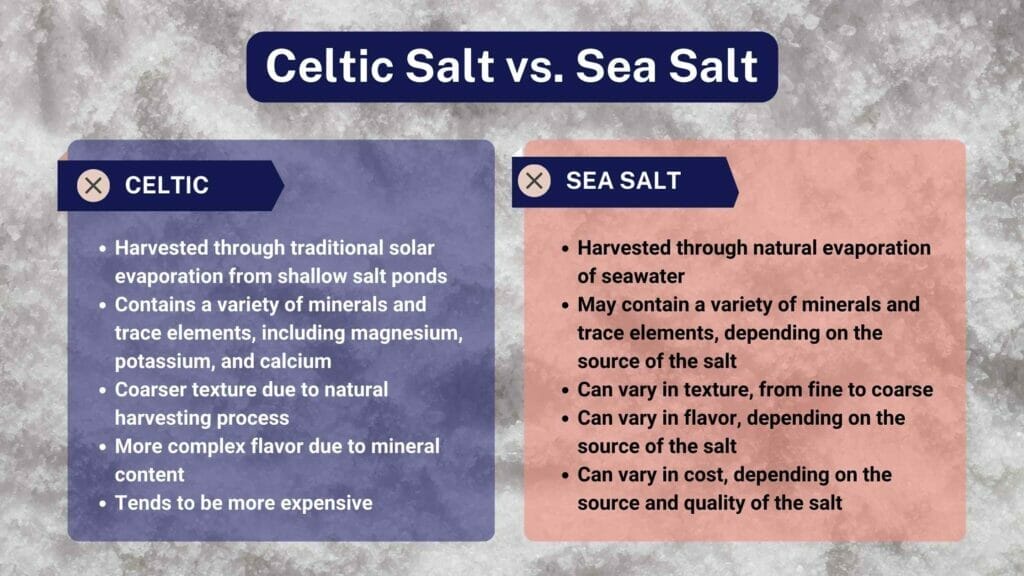
Sea salt can be harvested using a variety of methods, including solar evaporation, boiling, and vacuum evaporation. However, sea salt is generally less refined than table salt, which makes it a healthier alternative to table salt.
Texture
Celtic salt has a coarser texture than sea salt, which makes it ideal for use as a finishing salt or for adding texture to dishes. Its larger crystal size also makes it easier to sprinkle over food and control the amount used.
Sea salt has a finer texture than Celtic salt, which makes it easier to dissolve and use in cooking and baking.
Nutritional Value
Celtic salt has a higher nutritional value than sea salt due to its natural mineral content. A teaspoon of Celtic salt contains around 480 mg of sodium and 72 mg of potassium, along with other trace minerals.
Sea salt, on the other hand, generally contains less sodium than table salt, but it does not have as high a mineral content as Celtic salt. A teaspoon of sea salt contains around 2,300 mg of sodium, which is slightly less than table salt.
Celtic Salt vs Table Salt
Celtic salt and regular table salt are two popular types of salt that are commonly used in cooking and food preparation. Although both types of salt serve the same basic purpose of enhancing the taste of food, there are some notable differences between the two.
Mineral Content
Mineral content of 2000-year-old Celtic salt is higher than other salts but is still less than the healthiest salt on earth i.e. Pink Salt. Celtic salt is composed of potassium, magnesium, and calcium, along with several trace minerals. These minerals provide a range of health benefits, such as supporting nerve and muscle function, maintaining bone health, and regulating blood pressure.
In contrast, table salt is highly processed and stripped of most of its natural minerals, leaving behind primarily sodium and chloride.
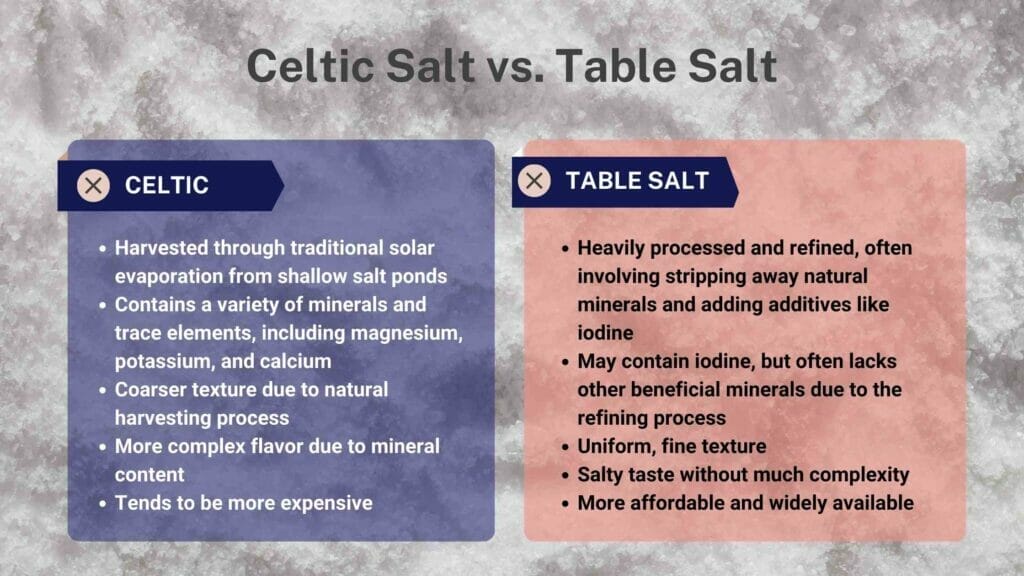
Processing
Celtic salt is harvested using traditional methods that involve evaporation of seawater under the sun and wind. This process retains the natural minerals found in the seawater, resulting in a less refined product that retains its natural flavor and texture.
In contrast, table salt is heavily processed to remove impurities and other minerals, resulting in a more uniform product that is easier to use in cooking and food preparation.
Texture
Celtic salt has a coarser texture than table salt, which makes it ideal for use as a finishing salt or for adding texture to dishes. Its larger crystal size also makes it easier to sprinkle over food and control the amount used.
Table salt, on the other hand, has a fine texture that dissolves quickly, making it ideal for use in recipes and for seasoning dishes while cooking.
Nutritional Value
Celtic salt has a higher nutritional value than table salt due to its natural mineral content. A teaspoon of Celtic salt contains around 480 mg of sodium and 72 mg of potassium, along with other trace minerals.
In contrast, a teaspoon of table salt contains around 2,300 mg of sodium and no other minerals. Excessive sodium intake can lead to health problems such as high blood pressure, so using a salt with a lower sodium content, such as Celtic salt, can be a healthier option.
Celtic Salt in water
When Celtic salt is added to water, it creates a mineral-rich solution that can offer several health benefits to the human body. These benefits include improved hydration, increased mineral intake, and better digestion. The minerals found in Celtic salt, such as magnesium and potassium, can help to balance electrolytes in the body and improve hydration levels.
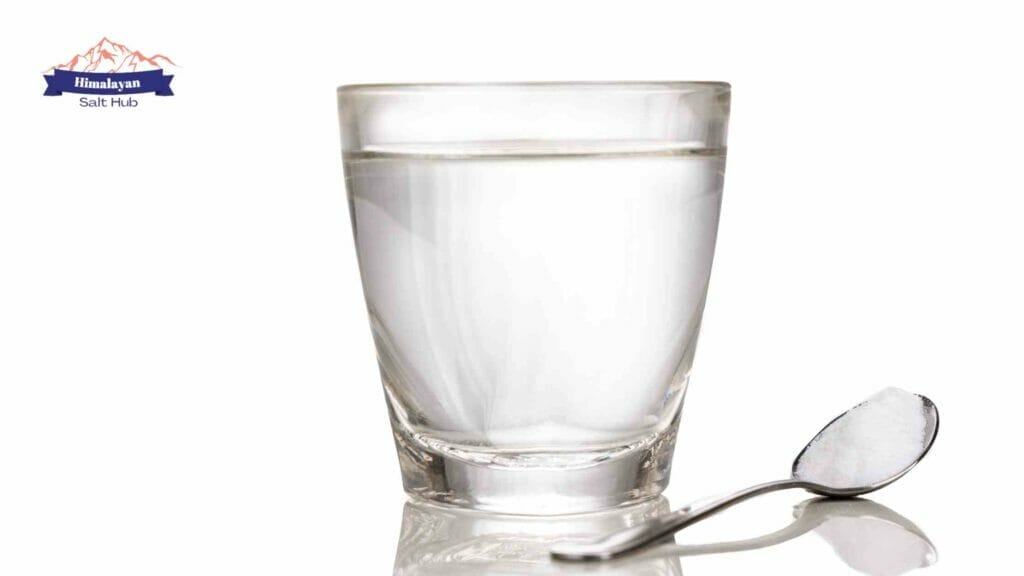
Additionally, these minerals can aid in digestion by stimulating the production of digestive enzymes and promoting healthy bowel movements. Overall, incorporating Celtic salt into your water can be a simple and effective way to support your overall health and wellness.
Celtic Sea Salt Side Effects
While doing Celtic Salt vs Himalayan Salt, it is necessary to mention the side effects of Celtic Salt.
- High blood pressure: One of the potential side effects of consuming Celtic sea salt is an increase in blood pressure. Celtic sea salt is high in sodium, which can cause water retention and contribute to high blood pressure, especially in individuals with hypertension or heart disease.
- Heavy metal toxicity: Celtic sea salt contains trace amounts of heavy metals such as lead and cadmium, which can accumulate in the body over time and cause toxicity. However, the levels of these metals in Celtic sea salt are generally low and are not considered a significant health risk.
- Dehydration: Consuming Celtic sea salt without enough water intake can cause dehydration. This is because salt draws water out of cells and into the bloodstream, leading to a decrease in overall hydration levels.
- Digestive issues: Celtic sea salt can have a laxative effect on the body, which can cause digestive issues such as diarrhea if consumed in excess. Additionally, some individuals may be sensitive to the mineral content of Celtic sea salt, which can cause gastrointestinal discomfort.
- Kidney and liver issues: People with kidney or liver disease should be cautious about consuming large amounts of Celtic sea salt, as it can worsen these conditions. This is because the kidneys and liver are responsible for regulating the body’s electrolyte balance, and too much salt can disrupt this balance.
- Skin irritation: In rare cases, topical application of Celtic sea salt can cause skin irritation or allergic reactions. This is more likely to occur in individuals with sensitive skin.
Overall, while Celtic sea salt can offer many health benefits when consumed in moderation, it’s important to be aware of these potential side effects and consume it responsibly.
Organic Celtic Salt: Best Celtic Salt on Amazon
Celtic grey salt is available in market and you can find it online on multiple websites too. Our team have tested and tried various brands of the Celtic salt and listed the best of them for you to buy from Amazon. These are not only our favorite but also recommended by the Amazon.
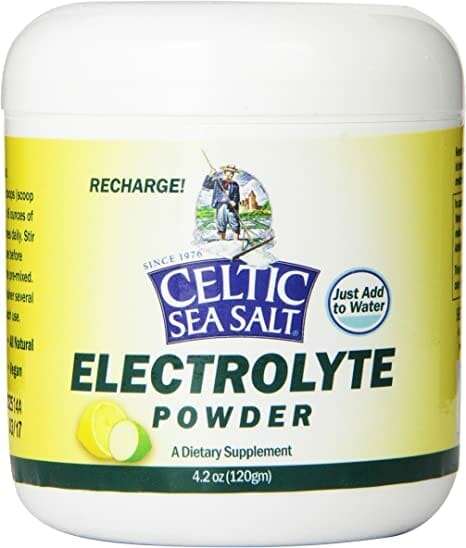 |
Celtic Sea Salt Electrolyte Powder Drink Mix |
Celtic Salt Near Me
If you’re looking for Celtic sea salt near you, there are a few places you can check. Health food stores, specialty grocery stores, and natural food co-ops often carry Celtic sea salt. You can also check online for retailers that sell Celtic sea salt, such as Amazon. Amazon offers a wide variety of Celtic sea salt products, including coarse, fine, and ground varieties. Our testers have listed out the best available Celtic Salt on amazon for you to buy as it is not available everywhere in market.
Himalayan Pink Salt and Celtic Sea Salt Recipes
Celtic Sea salt and Himalayan rock salt are used in number of delicious recipes. We have listed down some of our favorites for you to try!
Himalayan Pink Salt Caramel Sauce
Ingredients:
- 1 cup granulated sugar
- 1/4 cup water
- 1/2 cup heavy cream
- 2 tablespoons unsalted butter
- 1/2 teaspoon Himalayan pink salt
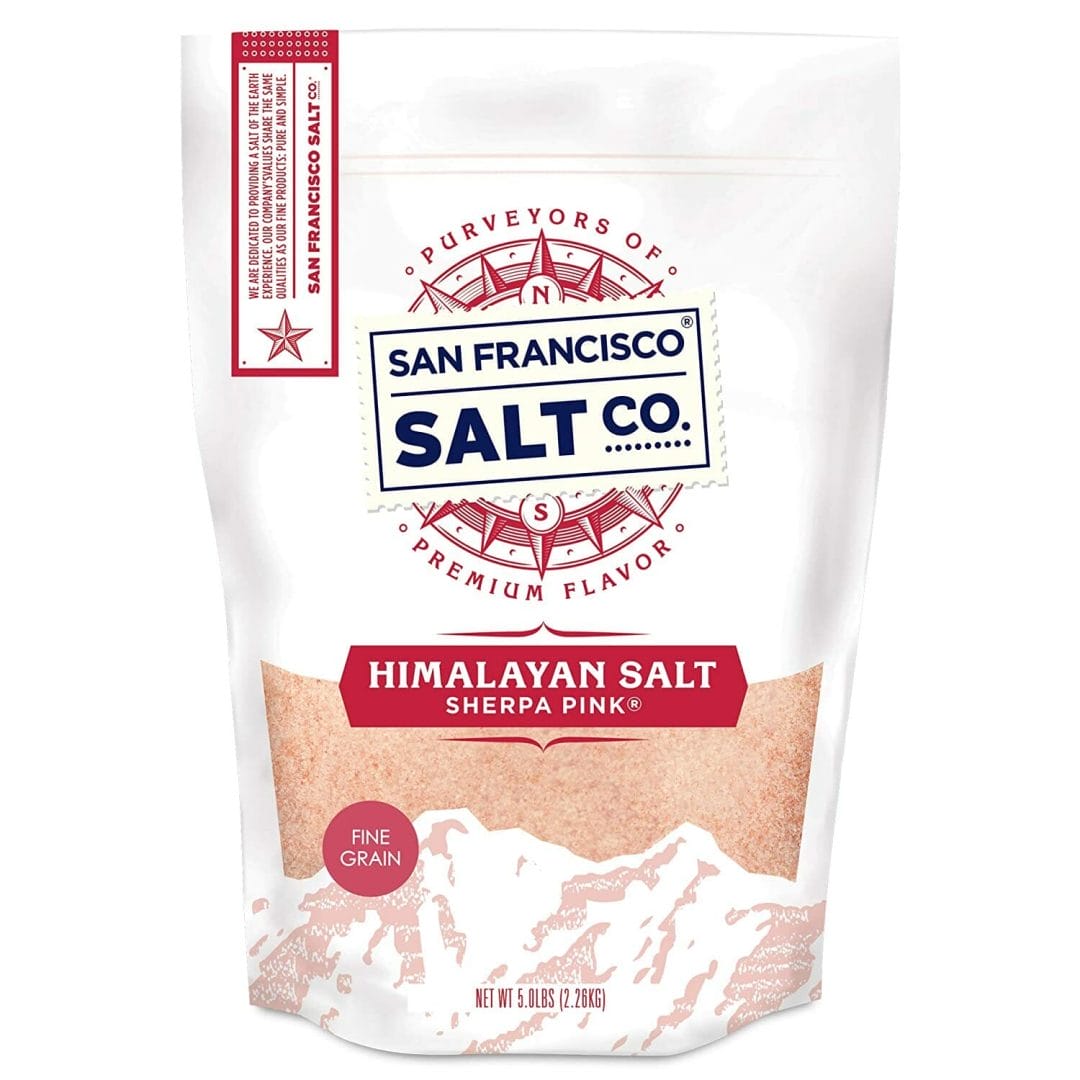 |  |  |
Sherpa Pink Himalayan Salt - 5 lbs. Fine Grain | Sherpa Pink Himalayan Salt - 10 lbs. Coarse Bulk Bag | Sherpa Pink Himalayan Salt - 2 lb. Bag Coarse Grain |
Instructions:
- In a medium saucepan, combine the granulated sugar and water over medium heat.
- Stir until the sugar dissolves, then let the mixture boil without stirring until it turns a deep amber color.
- Remove the pan from heat and carefully pour in the heavy cream. The mixture will bubble up, so be careful.
- Whisk in the butter until melted and smooth.
- Stir in the Himalayan pink salt until fully combined.
- Serve the caramel sauce warm over ice cream, cakes, or other desserts. Enjoy!
Himalayan Pink Salt Grilled Steak
Ingredients:
- 4 bone-in ribeye steaks
- 2 tablespoons olive oil
- 1 tablespoon coarse Himalayan pink salt
- 1/2 teaspoon freshly ground black pepper
Instructions:
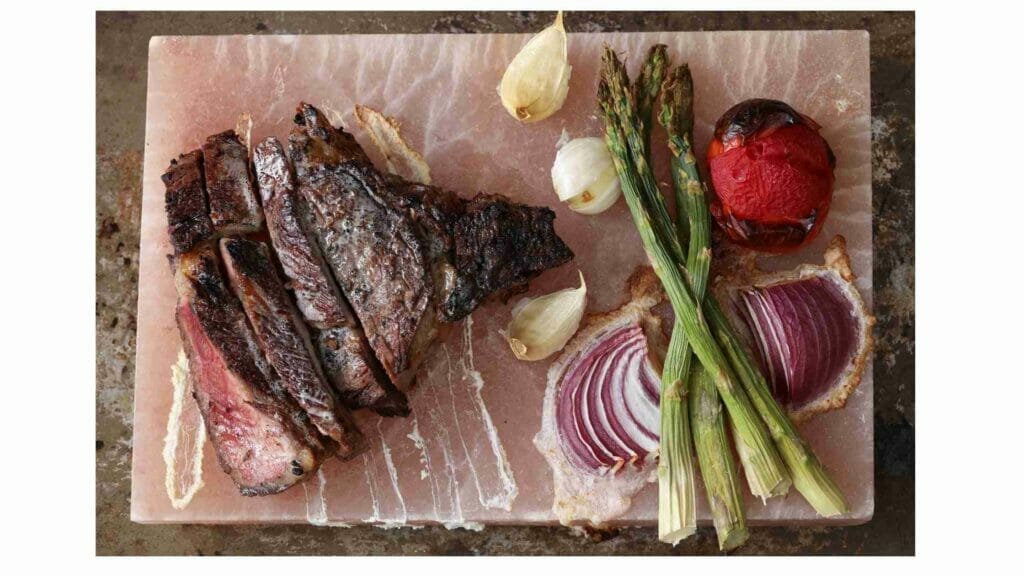
- Preheat a grill or grill pan to high heat.
- Brush the steaks with olive oil and season both sides with the Himalayan pink salt and black pepper.
- Place the steaks on the grill and cook for 4-5 minutes per side for medium-rare, or until cooked to your desired level of doneness.
- Remove the steaks from the grill and let them rest for 5-10 minutes before slicing and serving.
- Enjoy the juicy, flavorful steak with a sprinkle of extra Himalayan pink salt on top.
Celtic Sea Salt Lemon Garlic Roasted Chicken
Ingredients:
- 1 whole chicken (about 4 pounds)
- 2 tablespoons Celtic sea salt
- 1 tablespoon black pepper
- 1 tablespoon garlic powder
- 1 tablespoon paprika
- 2 tablespoons olive oil
- 1 lemon, sliced
- 4 garlic cloves, peeled and smashed
- Fresh herbs, such as rosemary or thyme
Instructions:
- Preheat the oven to 425°F (220°C).
- In a small bowl, mix together the Celtic sea salt, black pepper, garlic powder, and paprika.
- Rub the chicken all over with the olive oil, then rub the spice mixture all over the chicken, making sure to get under the skin and in the cavity.
- Stuff the lemon slices, smashed garlic cloves, and fresh herbs inside the chicken cavity.
- Place the chicken in a roasting pan and roast in the preheated oven for 1 hour and 15 minutes, or until the internal temperature reaches 165°F (74°C) and the skin is crispy and golden brown.
- Let the chicken rest for 10-15 minutes before carving and serving.
Why is Celtic salt better?
Celtic salt is considered better due to its retention of natural minerals and trace elements from traditional harvesting methods, potentially providing added health benefits and a more complex flavor profile.
Which salt is the healthiest?
Himalayan salt is recommended as the healthiest salt due to its natural mineral content and lack of additives.
Is Himalayan salt a Celtic sea salt?
No! Himalayan salt is better than Celtic Sea Salt
Is Celtic sea salt the healthiest salt?
While Celtic sea salt is a good option, Himalayan salt is considered the healthiest due to its mineral content and lack of environmental contaminants.
Conclusion
When it comes to choosing between the Celtic Salt vs Himalayan Salt, it ultimately comes down to personal preference and dietary needs. Those with a sodium-restricted diet may opt for Celtic Salt, which has a lower sodium content than table salt. On the other hand, those looking to add more minerals to their diet may prefer Himalayan Salt.
Additionally, some people may prefer the subtler flavor and slightly damp texture of Celtic Salt, while others may prefer the bold flavor and dry texture of Himalayan Salt. Ultimately, it’s important to consider the nutritional value, flavor, and environmental impact of each salt, and choose the one that best suits your individual needs and preferences.

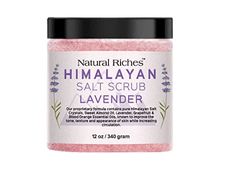
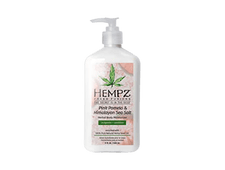
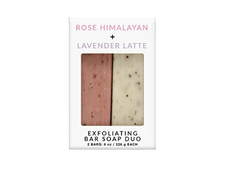





0 Comments
Trackbacks/Pingbacks